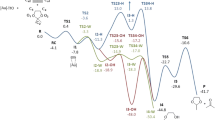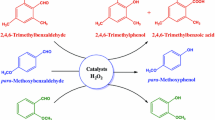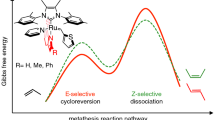Abstract
We used density functional theory to computationally design a Zr organometallic catalyst for selectively oxidizing substrates using molecular oxygen as oxidant without coreductant. Each selective oxidation cycle involves four general steps: (a) a peroxo or weakly adsorbed O2 group releases an O atom to substrate to form substrate oxide and an oxo group, (b) an oxygen molecule adds to the oxo group to generate an η2-ozone group, (c) the η2-ozone group rearranges to form an η3-ozone group, and (d) the η3-ozone group releases an O atom to substrate to form substrate oxide and regenerate the peroxo or weakly adsorbed O2 group. This catalyst could potentially be synthesized via the condensation reaction Zr(N(R)R′)4 + 2 C6H4–1,6-(N(C6H3–2′,6′-(CH(CH3)2)2)OH)2 → Zr(C6H4–1,6-(N(C6H3–2′,6′-(CH(CH3)2)2)O)2)2 [aka Zr_Benzol catalyst] + 4 N(R)(R′)H where R and R′ are CH3, CH2CH3, or other alkyl groups. For direct ethylene epoxidation, the computed enthalpic energetic span (i.e., effective activation energy for the entire catalytic cycle) is 27.1 kcal/mol, which is one of the lowest values for catalysts studied to date. We study reaction mechanisms and the stability of different catalyst forms as a function of the oxygen atom chemical potential. Notably, an aromatic linkage in each ligand prevents this catalyst from deactivating to form an inactive octahedral-like structure that contains the same atoms as the dioxo complex, Zr(Ligand)2(O)2. Due to a side reaction that can transfer an allylic H atom from alkene to catalyst, this catalyst is useful for directly epoxidizing alkenes such as ethylene that do not contain allylic H atoms. To better understand the reaction chemistry, we computed net atomic charges and bond orders for the two catalytically relevant reaction cycles. These results quantify electron transfer and bond forming and breaking during the catalytic process.
















Similar content being viewed by others
References
Cavani F (2010) J Chem Technol Biotechnol 85:1175–1183
Hermans I, Spier E, Neuenschwander U, Turra N, Baiker A (2009) Top Catal 52:1162–1174
Grzybowska-Swierkosz B (2000) Top Catal 11:23–42
Lenoir D (2006) Angew Chem Int Ed 45:3206–3210
Punniyamurthy T, Velusamy S, Iqbal J (2005) Chem Rev 105:2329–2363
Della Pina C, Falletta E, Prati L, Rossi M (2008) Chem Soc Rev 37:2077–2095
Shi Z, Zhang C, Tang C, Jiao N (2012) Chem Soc Rev 41:3381–3430
Mallat T, Baiker A (2004) Chem Rev 104:3037–3058
Sheldon R, Arends I, Ten Brink G, Dijksman A (2002) Acc Chem Res 35:774–781
Lin M (2001) Appl Catal A 207:1–16
Lei Y, Mehmood F, Lee S, Greeley J, Lee B, Seifert S, Winans RE, Elam JW, Meyer RJ, Redfern PC, Teschner D, Schlogl R, Pellin MJ, Curtiss LA, Vajda S (2010) Science 328:224–228
Van Santen RA, Kuipers H (1987) Adv Catal 35:265–321
Crotti P, Pineschi M (2006) In: Yudin AK (ed) Epoxides in complex molecule synthesis. Wiley-VCH, Weinheim, pp 271–314
Kahlich D, Wiechern U, Linder J (2012) In: Ullmann’s encyclopedia of industrial chemistry. Wiley-VCH Verlag GmbH & Co KGaA, Weinheim, pp 313–335
Xia QH, Ge HQ, Ye CP, Liu ZM, Su KX (2005) Chem Rev 105:1603–1662
Grigoropoulou G, Clark JH, Elings JA (2003) Green Chem 5:1–7
McGarrigle EM, Gilheany DG (2005) Chem Rev 105:1563–1602
International Energy Agency, International Council of Chemical Associations, DECHEMA Gesellschaft fur Chemische Technik und Biotechnologie E V (2013) Technology roadmap—energy and GHG Reductions in the chemical industry via catalytic processes, Paris, pp 1–56
Ozbek M, van Santen R (2013) Catal Lett 143:131–141
Nijhuis TA, Makkee M, Moulijn JA, Weckhuysen BM (2006) Ind Eng Chem Res 45:3447–3459
Manz TA, Yang B (2014) RSC Adv 4:27755–27774
Yang B, Manz TA (2015) RSC Adv 5:12311–12322
Stanciu C, Jones ME, Fanwick PE, Abu-Omar MM (2007) J Am Chem Soc 129:12400–12401
Lubben TV, Wolczanski PT (1985) J Am Chem Soc 107:701–703
Lubben TV, Wolczanski PT (1987) J Am Chem Soc 109:424–435
Frisch MJ, Trucks GW, Schlegel HB, Scuseria GE, Robb MA, Cheeseman JR, Scalmani G, BaroneV, Mennucci B, Petersson GA, Nakatsuji H, Caricato M, Li Z, Hratchian HP, Izmaylov AF, Bloino J, Zheng G, Sonnenberg JL, Hada M, Ehara M, Toyota K, Fukuda R, Hasegawa J, Ishida M, Nakajima T, Honda Y, Kitao O, Nakai H, Vreven T, Montgomery JAJ, Peralta JE, Ogliaro F, Bearpark M, Heyd JJ, Brothers E, Kudin KN, Staroverov VN, Keith T, Kobayashi R, Normand J, Raghavachari K, Rendell A, Burant JC, Iyengar SS, Tomasi J, Cossi M, Rega N, Millam JM, Klene M, Knox JE, Cross JB, Bakken V, Adamo C, Jaramillo J, Gomperts R, Stratmann RE, Yazyev O, Austin AJ, Cammi R, Pomelli C, Ochterski JW, Martin RL, Morokuma K, Zakrzewski VG, Voth GA, Salvador P, Dannenberg JJ, Dapprich S, Daniels AD, Farkas O, Foresman JB, Ortiz JV, Cioslowski J, Fox DJ (2010) Gaussian 09, Gaussian, Inc., Wallingford CT, Revision C.01
Becke AD (1993) J Chem Phys 98:5648–5652
Stephens PJ, Devlin FJ, Chabalowski CF, Frisch MJ (1994) J Phys Chem 98:11623–11627
Hratchian HP, Schlegel HB (2004) J Chem Phys 120:9918–9924
Hratchian HP, Schlegel HB (2005) J Chem Theory Comput 1:61–69
Schröder D, Shaik S, Schwarz H (2000) Acc Chem Res 33:139–145
Harvey JN, Poli R, Smith KM (2003) Coord Chem Rev 238–239:347–361
Green JC, Harvey JN, Rinaldo P (2002) J Chem Soc Dalton Trans 31:1861–1866
Manz TA, Sholl DS (2011) J Chem Theory Comput 7:4146–4164
Manz TA, Sholl DS (2012) J Chem Theory Comput 8:2844–2867
Manz TA, Limas NG (2015) DDEC6: A method for computing even-tempered net atomic charges in periodic and nonperiodic materials, pp 1–97. arXiv:1512.08270 [physics.chem-ph]
Manz TA, Gabaldon Limas N (2015) Chargemol program for performing DDEC analysis, version 3.4, December 2015, ddec.sourceforge.net
Kozuch S, Shaik S (2011) Acc Chem Res 44:101–110
Manz TA, Sholl DS (2010) J Comput Chem 31:1528–1541
Gellman AJ (2002) J Phys Chem B 106:10509–10517
Gellman AJ (2000) Acc Chem Res 33:19–26
Gellman AJ, Buelow MT, Street SC, Morton TH (2000) J Phys Chem A 104:2476–2485
Cossi M, Barone V, Cammi R, Tomasi J (1996) Chem Phys Lett 255:327–335
Cossi M, Rega N, Scalmani G, Barone V (2001) J Chem Phys 114:5691–5701
Pascual-Ahuir JL, Silla E, Tuñón I (1994) J Comput Chem 15:1127–1138
York DM, Karplus M (1999) J Phys Chem A 103:11060–11079
Scalmani G, Frisch MJ (2010) J Chem Phys 132:114110
Shin SB, Chadwick D (2010) Ind Eng Chem Res 49:8125–8134
Blanco-Brieva G, Capel-Sanchez MC, de Frutos MP, Padilla-Polo A, Campos-Martin JM, Fierro JLG (2008) Ind Eng Chem Res 47:8011–8015
Zhao JL, Zhou JC, Su J, Guo HC, Wang XS, Gong WM (2007) AIChE J 53:3204–3209
Kamata K, Yonehara K, Sumida Y, Yamaguchi K, Hikichi S, Mizuno N (2003) Science 300:964–966
Ghanta M, Fahey DR, Busch DH, Subramaniam B (2013) ACS Sustain Chem Eng 1:268–277
Zuwei X, Ning Z, Yu S, Kunlan L (2001) Science 292:1139–1141
Lee HJ, Shi TP, Busch DH, Subramaniam B (2007) Chem Eng Sci 62:7282–7289
Lane BS, Burgess K (2003) Chem Rev 103:2457–2473
Liu YY, Murata K, Inaba M (2004) Chem Commun 40:582–583
Yoshida H, Murata C, Hattori T (2000) J Catal 194:364–372
Chu H, Yang L, Zhang QH, Wang Y (2006) J Catal 241:225–228
Kahn M, Seubsai A, Onal I, Senkan S (2010) Top Catal 53:86–91
Liu Y, Murata K, Inaba M (2006) Chem Lett 35:436–437
Murata K, Liu Y, Mimura N, Inaba M (2003) J Catal 220:513–518
Yang LJ, He JL, Zhang QH, Wang Y (2010) J Catal 276:76–84
Ghosh S, Acharyya S, Tiwari R, Sarkar B, Singha R, Pendem C, Sasaki T, Bal R (2014) ACS Catal 4:2169–2174
Lundin A, Panas I, Ahlberg E (2009) J Phys Chem A 113:282–290
de Visser S, Kaneti J, Neumann R, Shaik S (2003) J Org Chem 68:2903–2912
Joshi A, Delgass W, Thomson K (2007) J Phys Chem C 111:7841–7844
Comas-Vives A, Lledos A, Poli R (2010) Chem Euro J 16:2147–2158
Dinoi C, Ciclosi M, Manoury E, Maron L, Perrin L, Poli R (2010) Chem Eur J 16:9572–9584
Herbert M, Montilla F, Alvarez E, Galindo A (2012) Dalton Trans 41:6942–6956
Kuznetsov ML, Pessoa JC (2009) Dalton Trans 38:5460–5468
Jee J, Comas-Vives A, Dinoi C, Ujaque G, van Eldik R, Lledos A, Poli R (2007) Inorg Chem 46:4103–4113
Hammond GS (1955) J Am Chem Soc 77:334–338
Leffler JE (1953) Science 117:340–341
Acknowledgments
Supercomputing resources were provided by the Extreme Science and Engineering Discovery Environment (XSEDE). XSEDE is funded by NSF grant OCI-1053575. XSEDE project grant TG-CTS100027 provided allocations on the Stampede cluster at the Texas Advanced Computing Center (TACC) and the Trestles and Comet clusters at the San Diego Supercomputing Center (SDSC). The authors sincerely thank the technical support staff of XSEDE, TACC, and SDSC. The authors also thank Dr. Karen Goldberg and Wilson Bailey for useful discussions regarding the proposed catalyst synthesis reaction.
Author information
Authors and Affiliations
Corresponding author
Ethics declarations
Conflict of interest
The authors and NMSU’s Office of Intellectual Property (Arrowhead Center, Inc.) have applied for a patent on some of the results described in this paper.
Electronic supplementary material
Below is the link to the electronic supplementary material.
214_2015_1789_MOESM1_ESM.pdf
Online Resource 1: DFT-optimized geometries and energies; imaginary frequency for each transition state; triplet-quintet crossing curves for O2 addition to the oxo complex; table of computed relative energies (ESCF, EZP, H, and G) for the Zr_Benzol catalyst with various oxygen-comprised adsorbates; table of assigned spin magnetic moments for triplet complexes; junior and master catalytic cycles and relative energy profiles for direct propene epoxidation using the Zr_Benzol catalyst. (PDF 11509 kb)
214_2015_1789_MOESM2_ESM.zip
Online Resource 2: A 7z format archive containing .xyz files (which can be read using any text editor or the free Jmol visualization program downloadable from jmol.sourceforge.net) containing net atomic charges, bond orders, and atomic spin moments (for spin-polarized systems) for all of the DFT-optimized geometries. (ZIP 2322 kb)
Rights and permissions
About this article
Cite this article
Yang, B., Manz, T.A. Computationally designed zirconium organometallic catalyst for direct epoxidation of alkenes without allylic H atoms: aromatic linkage eliminates formation of inert octahedral complexes. Theor Chem Acc 135, 21 (2016). https://doi.org/10.1007/s00214-015-1789-1
Received:
Accepted:
Published:
DOI: https://doi.org/10.1007/s00214-015-1789-1




